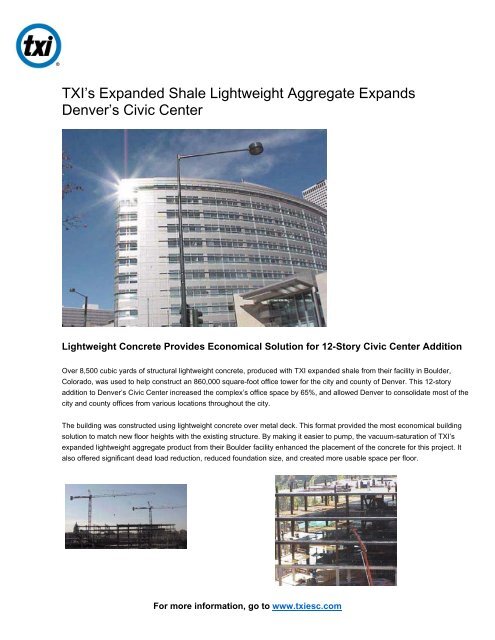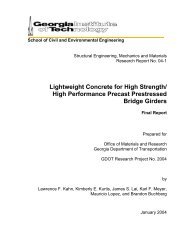TXI's Expanded Shale Lightweight Aggregate Expands Denver's ...
TXI's Expanded Shale Lightweight Aggregate Expands Denver's ...
TXI's Expanded Shale Lightweight Aggregate Expands Denver's ...
You also want an ePaper? Increase the reach of your titles
YUMPU automatically turns print PDFs into web optimized ePapers that Google loves.
TXI’s <strong>Expanded</strong> <strong>Shale</strong> <strong>Lightweight</strong> <strong>Aggregate</strong> <strong>Expands</strong><br />
Denver’s Civic Center<br />
<strong>Lightweight</strong> Concrete Provides Economical Solution for 12-Story Civic Center Addition<br />
Over 8,500 cubic yards of structural lightweight concrete, produced with TXI expanded shale from their facility in Boulder,<br />
Colorado, was used to help construct an 860,000 square-foot office tower for the city and county of Denver. This 12-story<br />
addition to Denver’s Civic Center increased the complex’s office space by 65%, and allowed Denver to consolidate most of the<br />
city and county offices from various locations throughout the city.<br />
The building was constructed using lightweight concrete over metal deck. This format provided the most economical building<br />
solution to match new floor heights with the existing structure. By making it easier to pump, the vacuum-saturation of TXI’s<br />
expanded lightweight aggregate product from their Boulder facility enhanced the placement of the concrete for this project. It<br />
also offered significant dead load reduction, reduced foundation size, and created more usable space per floor.<br />
For more information, go to www.txiesc.com
"One of the many benefits of using lightweight concrete on the floor decks of the Civic Center is that it helped save 1 1/4 inches<br />
per floor in the height of the building, which equates to a savings in the curtain wall alone of $55,000, and allowed us to align<br />
the new building floor to floor with the existing 1950’s structure. It also provided savings in the foundation, shaftwalls, and lateral<br />
system." Michael McAffrey, a principal at Martin and Martin Consulting Engineers.<br />
Advantages<br />
Martin and Martin designs and specifies Structural <strong>Lightweight</strong> Concrete projects across the nation. The benefits of specifying<br />
Structural <strong>Lightweight</strong> <strong>Aggregate</strong> Concrete include the following:<br />
Dead Load Reduction – A reduced in-place density equates to smaller foundations, or the ability to use a site with poor or<br />
marginal soil conditions.<br />
More Leasable Space – Reduced dead load often results in the ability to utilize smaller columns. Smaller columns and/or<br />
potentially greater spans create more gross leasable space.<br />
Ability to Design to a Specified Density – Applying “specified density” technology saves time and money. In the<br />
precast/prestress market, manufacturers and specifiers have the benefit of using concrete ranging from 100 to 135 lbs/ft 3 . Since<br />
more precast elements can be shipped on a truck, this flexibility can result in substantial transportation cost savings even with a<br />
modest density (unit weight) reduction.<br />
In the ready mix market, specified density concrete offers the designer the maximum design flexibility in meeting project<br />
requirements and accommodating artistic expression.<br />
Structural <strong>Lightweight</strong> Concrete’s Superior Fire Ratings Reduce Spray-On Fire<br />
Proofing – <strong>Lightweight</strong> aggregate concrete is more fire resistant than normalweight<br />
concrete. A 3.75-inch thick lightweight concrete panel will supply two-hour fire<br />
endurance. It would take 5 inches of normalweight concrete to supply equal endurance.<br />
High Performance Seismic Design – Reducing the mass of a structure reduces the<br />
seismic inertial forces.<br />
Internal Curing – The porous nature of the lightweight aggregate allows it to absorb<br />
water. This absorbed water contributes to the continuous hydration of the cementitious<br />
materials. The absorbed water is not part of the mixing water and does not effect the<br />
water/cementitious ratio.<br />
Construction<br />
The <strong>Expanded</strong> <strong>Shale</strong> for the project was Vacuum Saturated by <strong>TXI's</strong> Boulder, Colorado<br />
facility. This contributed to insuring the construction schedule was met. “The contractor<br />
had implemented a vigorous placement rate for the Structural <strong>Lightweight</strong> Concrete and<br />
the Vacuum Saturation process for the aggregate greatly enhanced the placeability of the concrete,” reported Miles Dee, Sales<br />
Manager Colorado, TXI-Western <strong>Aggregate</strong>s.<br />
The concrete mixture was specified at 3500 psi with 15% Class F flyash allowed in the total cementitious content. The slump<br />
tolerance was 4" to 6" at point of placement, with an equilibrium density of 110 lb/ft 3 (+/- 3 lb/ft 3 ).<br />
For more information, go to www.txiesc.com















